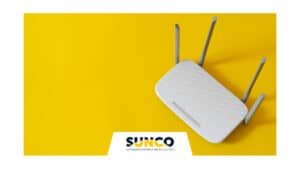Stop us if you’ve heard this one before…
One fateful night, you’re enjoying some family time, curled up on the couch while watching a movie. Out of the blue, your phone rings. You glance at it suspiciously—you don’t usually receive calls at this hour—but the number appears normal, maybe it even has your local area code. You answer it, half out of curiosity and half with genuine concern. The voice on the other end replies robotically, “This is a call on behalf of the Canada Revenue Agency in regard to your overdue balance. This amount has now been sent to collections and there is a warrant out for your arrest.” You hang up, and immediately begin googling.

Has this ever happened to you? Does your search history include “phone scams in Alberta” or “how to know if a number is fake”? You’re not alone.
Robocalls and number spoofing have made consumers more hesitant to answer calls from unfamiliar numbers, making it harder for legitimate businesses trying to reach people by phone.
What is Caller ID spoofing?
Caller ID Spoofing is a technique in which the caller masks their identity or purposely makes it appear that the call is from a legitimate source or number. Often, the number appears familiar, from someone nearby with the same area code or from a well-known agency.
There are beneficial scenarios in which Caller ID spoofing is used legitimately to deliver time sensitive information. For example, a doctor calling a patient from their personal mobile phone with a call back ID associated with their practice’s office. Other scenarios include enterprises using multiple outbound voice providers, or school closure notifications.
But there are plenty of negative situations that also arise, like the Canadian Revenue Agency or Social Insurance Number scam described above. Even Sunco Communication & Installation has targeted to negative Caller ID Spoofing. Recipients appear to be receiving a call from the Sunco number, when in fact, the call is coming from a fraudulent source fronting as Sunco.
Cue SHAKEN/STIR Protocols in Canada
What is SHAKEN/STIR?
SHAKEN/STIR is a suite of protocols and procedures intended to combat negative caller ID spoofing by providing authentication and verification of caller ID information. This works similarly to an SSL certificate on a website or spam filtering in emails. STIR is short for Secure Telephony Identity Revisited, while its partner SHAKEN stands for Signature-based Handling of Asserted information using toKENs. Together, their namesake represents the CRTC’s strategy to reduce phone fraud in honor of a well-known spy’s cocktail order (Bond. James Bond.)
How do SHAKEN/STIR protocols work?
SHAKEN/STIR protocols are enacted in scenarios like the following:
- Bob places a call through an Originating Service Provider (OSP) to Nancy.
- The OSP collects call parameters, such as from what number, to whom, when the call is placed, and so on, and uses a “signing service” to sign the call. What this means is that the OSP gets a certificate of authentication, signs the call parameters, and forwards the parameters through the telecom network to the Terminating Service Provider (TSP)—aka, Nancy’s service provider.
- The call arrives at the TSP with the cryptographically signed parameters.
- The TSP has a “verification service” that downloads the OSP’s certificates and verifies that the calling parameters are correct. The TSP knows the level of confidence that the OSP promises to ensure that the call is authorized.
- The call arrives at Nancy’s cell phone, indicating that the caller has been verified upon receiving the incoming call.
SHAKEN/STIR asks questions like:
- Is the outbound caller a customer of the phone carrier that the number they are using is associated with?
- Did the carrier assign the phone number being used by the caller? Or could it possibly be another provider’s number, a third-party contact center, or someone calling on behalf of an organization?
- Did the carrier originate the call, or did it come from a gateway (i.e. internationally)?
This system was originally implemented in the United States as a result of the “nuisance call” epidemic and they have since seen significant benefits. It is now mandated by both the Canadian Radio-television and Telecommunications Commission (CRTC) and the Federal Communications Commission for all telecommunications companies to utilize STIR/SHAKEN in Canada by November 30, 2021, to continue offering services. Similar to Do Not Call legislation in Canada, the CRTC is dedicated to reducing the number of phone scams and spam via this method.
How STIR/SHAKEN affects Sales teams and businesses
Calling architecture is very important for contact centres. With STIR/SHAKEN, your authentication rating could stop calls from reaching customers. For example, least call routing is a common practice call centres use to decrease costs. This method of routing calls searches for the most inexpensive route possible, and as a result, the call is routed through several networks that may be seen as untrustworthy to some carriers. Thus, the call may be flagged, blocked, or simply ignored by your customers.
The implementation of SHAKEN/STIR will transform customers calling experience and will help them build trust in the validity of the calls they are receiving, leading to better communication and better business. If you have concerns about Caller ID spoofing for your business, contact Sunco today! There’s no time to wait.




